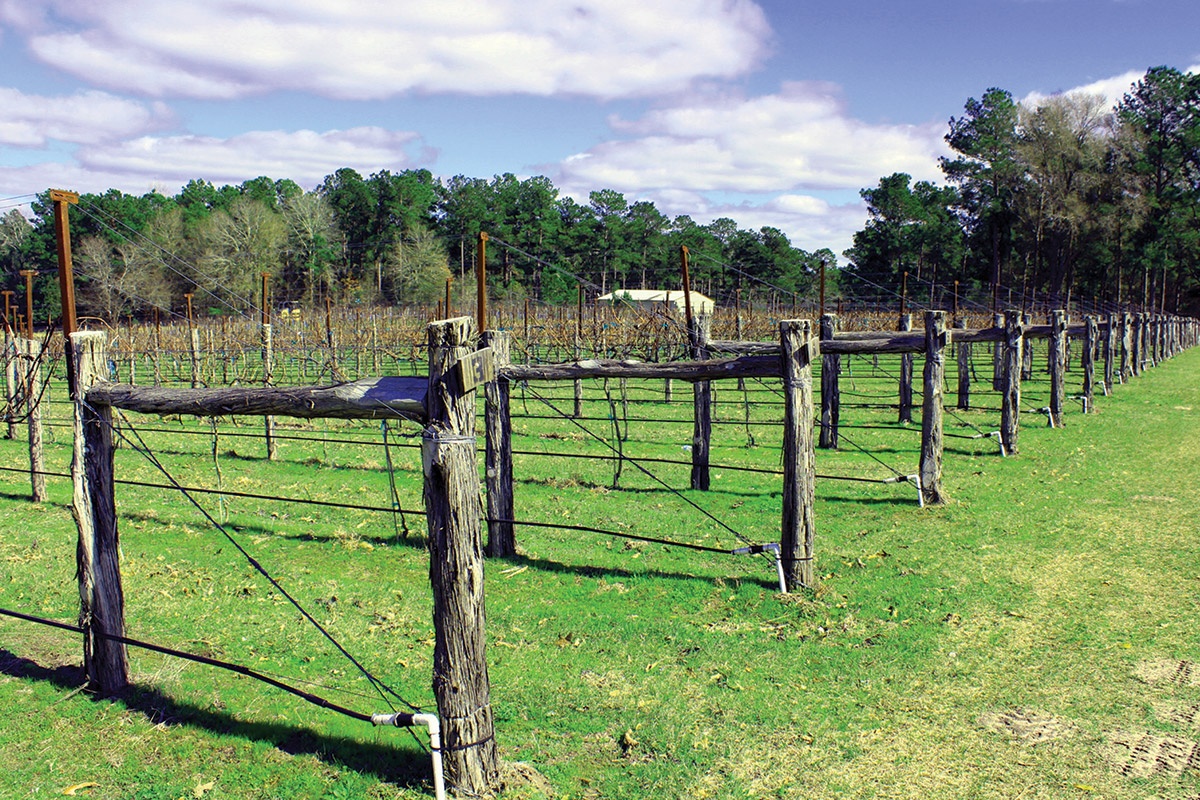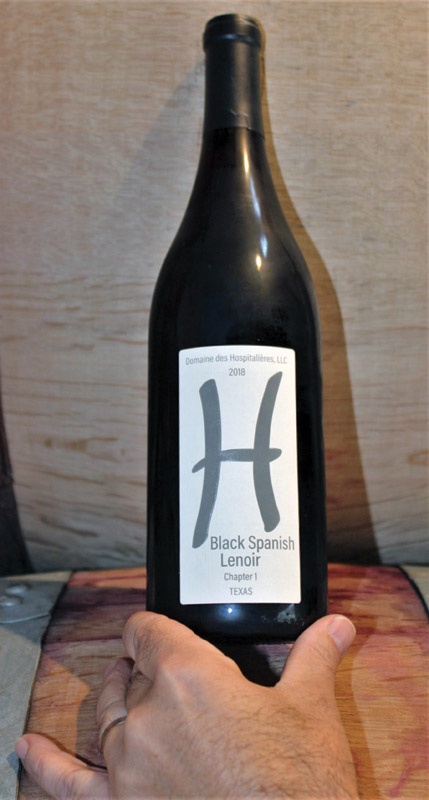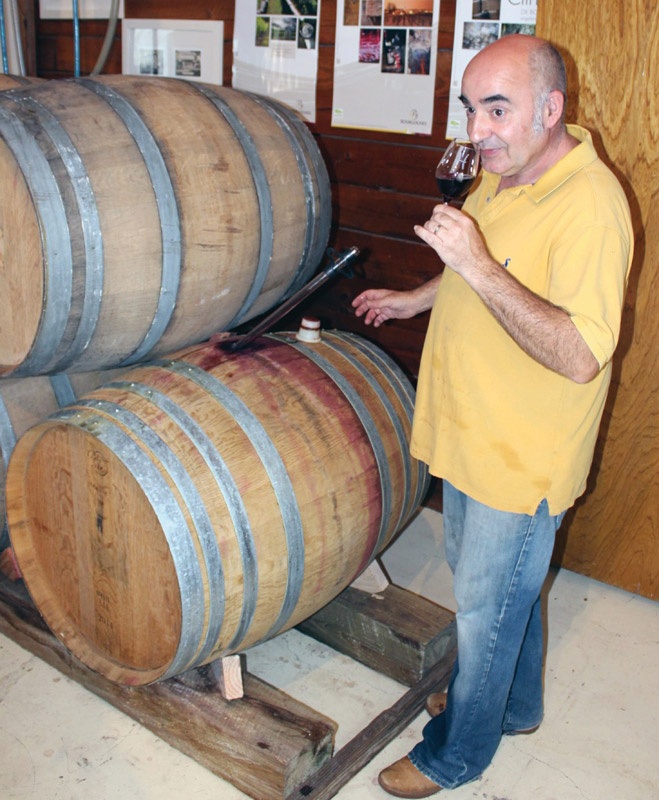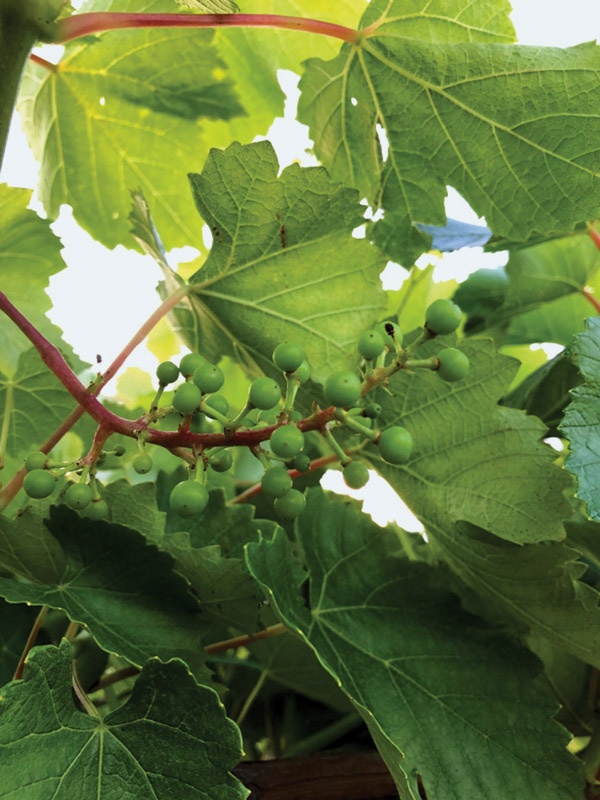Ask anyone to name the best wine-growing region in France and they’ll probably say Bordeaux. Ask them about California and they will most likely answer Napa. And if you ask about Texas, the popular answer might be Fredericksburg.
But if they answer East Texas, they aren’t too far off.
A new industry is growing in areas of East Texas, from Huntsville to Coldspring to Livingston and points in between. Over the past five years, almost a dozen wineries have sprung up, offering visitors a chance to taste wines made from locally grown grapes such as the blanc du bois (for white wines) and black Spanish lenoir (for red wines).
Why did all the vineyards pop up so suddenly? In most cases, it was entrepreneurship. At least that’s what happened with Joe and Lynn Zimmerman, owners of Teysha Vineyard in Huntsville.

Barrels used to age wines at H-Wines in Coldspring were brought from France by vintner Steve Hari.
“I was working in the oil industry overseas, and Lynn was here most of the time managing our ranch,” Joe Zimmerman said. “She decided to plant a few rows of blanc du bois grapes, which are hybrids that grow in this area. When I got back in 2013, they were growing so well we decided to plant more. We now have about 1,900 plants and about 2.4 miles of trellises that we need to operate. We had our second harvest last year, which yielded about 8 tons of grapes from our little vineyard, and we’re hoping to get 12 tons this year.”
With almost 2,000 vines, Zimmerman had to decide what to do with the harvest. The choice was easy.
“It just seemed like the timing was right, and it also seemed like a great business opportunity. We found a great vintner/producer in Nacogdoches, and once that was in place, we were off and running,” he said.

Teysha Vineyard owners Joe and Lynn Zimmerman check some of their blanc du bois vines on pruning day in Huntsville.
Teysha Vineyard now produces and sells several different varieties of wines, including lenoir and sweet blanc du bois, but they have also branched out into other wines, including some from grapes harvested in the Texas High Plains. Due to a great harvest last year of the black Spanish grapes, they are considering making a port wine, which combines the grapes and brandy. “We’re experimenting with that right now,” Zimmerman said.
Near Lake Livingston in Coldspring, you’ll find a large vineyard called Carriage House Farm and Vineyard, owned by Judi and John Benestante. Carriage House also produces black Spanish lenoir and blanc du bois grapes. Their entire harvest goes to Coldspring vintner H-Wines, owned by Steve Hari and Phillipe Legrand, two veteran winemakers from France.
“Our model is different from a lot of other models,” John Benestante said. “We’re going more for the venue model. Our grapes only go to one winemaker, but we eventually want to have a tasting room here where we will feature wines from many different local wineries, like H-Wines, of course, and also Haak Winery in Santa Fe, Messina Hof in Bryan and many others. Our goal is to have a nice venue for weddings and other celebrations where folks can have the beautiful backdrop of our vineyard and enjoy the occasion with some fine wines.”

Coldspring’s H-Wines has a tasting room in Montgomery, where visitors can sample wine varietals such as blanc du bois, left, and lenoir, right.
The vineyard has been producing grapes for several years under the watchful eyes of the Benestantes, and even though the vineyard has reached a level of maturity to produce large numbers of grapes, everything is still dependent on the weather. A late freeze or a dry summer can ruin an entire year’s crop. But no matter the circumstance, growing grapes is always a full-time job.
“It’s very physical work,” Judi Benestante said. “From early February until harvest time in August or September, we’ll work every day out there. You just don’t get any time off. These vines can grow up to a foot every day, so it’s critical that we monitor and prune them so the vines stay strong to produce the best quality grape. When it’s time to prune, and again when it’s harvest time, we invite anyone who wants to help over to the vineyard. We have snacks and drinks, and it has become somewhat of a tradition here.”
According to Judi Benestante, the vines will produce grapes whether they are pruned daily or not. But knowing exactly when and where to prune, using the best fungicides and insecticides, and making sure that there is just enough (and not too much) water will yield a better grape, which in turn makes a better wine.

Teysha Vineyard in Huntsville has nearly 2,000 vines, including blanc du bois and lenoir varieties.
And that’s where the experience of a veteran vintner like Steve Hari of H-Wines comes in.
Hari came to Texas from his native France, where he spent 24 years as a winemaker. “I like working with the blanc du bois grapes and the lenoir as well,” Hari said. “The blanc du bois grapes are also grown in France as well as the U.S., and the lenoir are native to Spain. These hybrids are more disease resistant, especially to Pierce’s disease, which is taking a very heavy toll on both California and French vintages.”
Pierce’s disease is caused by a bacteria and can wipe out entire regions if not properly controlled. In the 1880s, the disease infected more than 40,000 acres of vines in southern California and devastated vineyards. It took several decades before successful wine production resumed there.
The disease spread to Texas via insects, but thanks to viticulture experts at Texas A&M and Texas Tech universities, disease-tolerant varietals have been created that allow for the safe growing of lenoir and blanc du bois grapes.

In Richards, just west of Sam Houston National Forest, you will find West Sandy Creek Winery and its new state-of-the-art tasting room.
“H-Wines gets the entire yield of grapes from Carriage House, as well as from other growers,” Hari said. “From that, we were able to produce about 150 cases of blanc du bois and over 300 cases of lenoir last season. It also enabled us to produce some other blended wines using the skins and seeds from the lenoir grape. We’re still experimenting with some blends to release with future vintages.”
In addition to their Coldspring winery, H-Wines also has a tasting room in Montgomery, housed in the old First State Bank building, an official state historic site. Patrons to the tasting room can sample cheeses and other snacks while enjoying the locally produced wines, as well as other varietals from France such as chardonnay, pinot noir and gewürztraminer from the Alsace-Lorraine region.
“We get quite the crowd every weekend at our tasting room,” Hari said. “A few other tasting rooms have opened up in the area, so it’s almost like people can walk from one place to another and enjoy all the different kinds of wines.”
The choices of different wines in the area gave Teysha’s Zimmerman an idea. Why not join together with all of the other area wineries and form a coalition of wineries for residents and visitors to enjoy?
And that’s how the Sam Houston Wine Trail was born.
The Sam Houston Wine Trail consists of eight local wineries: Blue Epiphany Vineyards in Conroe; Tempe Creek Vineyard and Farms in Livingston; Golden Oak Micro Cellar in New Waverly; Teysha Vineyard in Huntsville; H-Wines in Coldspring and Montgomery; Tosca Winery in New Waverly; Froggy Wines in Huntsville; and West Sandy Creek Winery in Richards.
Visitors to the wineries on the trail are able to sample all kinds of wines. For example, Froggy Wines specializes in uniquely named wines such as Chocolate Retreat, Texas Sun Moscato, Ringo Rose and Puppy Paws.
“This is an exciting group of growers and winemakers, all of whom are located in the beautiful rolling, piney hills of East Texas,” Zimmerman said. “We think the lovely and relaxing setting of our members’ locations, as well as the award-winning wines served at these tasting rooms, is the best kept secret in Texas. Most of the wineries involved will have various special events throughout the year as well as availabilities for private events like weddings. Most of the public events are included on the newly launched website, samhoustonwinetrail.com.”
Blue Epiphany Vineyards in Conroe was formed in 2017, when founder James Barber, a member of the Montgomery County Sheriff’s Department, had an epiphany that he should leave his job and start a winery. Barber was joined by fellow officers Jack Solomon, Chris Dowell, Frank Mitchell and Jonathon Roach to help create Conroe’s first winery.
Now, in addition to wines, the vineyard also sells mead, oils and vinegars, and custom apparel. Their logo features a thin blue line in the center and a five-point star reminiscent of the badge worn by the deputies. Some of their wines also carry law enforcement-related names such as Night Shift and 18 Days.
The Sam Houston Wine Trail follows the success of the Piney Woods Wine Trail, which was founded in 2010 and has 20 wineries and vineyards throughout the Piney Woods region. This trail covers cities from Athens to Palestine and Tyler to Nacogdoches. In addition to the economic benefits to the region and the diversification that the burgeoning industry brings, the combination of both of these trails is quickly making East Texas a wine mecca and major tourist destination for wine lovers.











